
This is the ceremonial entrance of the Ara Pacis, where a flight of low stairs leads down to the broad expanse of the great sundial (horologium Augusti) set up by Augustus on the Campus Martius in 10 BCE. The processions on both walls have led you to this point, and you turn to gaze at the sculpted panels flanking the front of the sacrificial altar, noting that both of these refer back to the legendary origins of Rome. On the right panel, you see a bearded man preparing to sacrifice a sow before a shrine with two seated male deities; behind him stands a male companion, while two youthful attendants help him prepare the sacrifice. The sow immediately brings to mind the Trojan Aeneas, who sacrificed a white sow with 30 piglets on the banks of the Tiber; in this case, the camillus, holding a plate of fruits, a fringed mantele, and a ritual pitcher might be Aeneas's son Iulus, legendary founder of Augustus's Julian family, and the deities might be the city gods Aeneas brought from Troy (Penates). But the hero's beard suggests another figure from Rome's legendary past, the religious lawgiver Numa Pompilius, second king of Rome, always shown as a mature, bearded man. You think to yourself that Augustus may have intended to suggest both of these heroic legendary figures and identify them with himself--Aeneas as founder of his family line and Numa as inspiration for his role as restorer of Roman religious traditions; in any case, you can't help but notice that of all the men represented on the altar only Augustus and Aeneas/Numa have a veiled head topped by a laurel wreath.
One the left panel, you see the Lupercal cave on the Palatine Hill with the wolf suckling Romulus and Remus between the god Mars, their father, the the shepherd Faustulus who found and fostered the twins. You remember that it was rumored that Augustus once considered taking Romulus as his cognomen before deciding on Augustus:
Postea Gai Caesaris et deinde Augusti cognomen assumpsit, alterum testamento maioris avunculi, alterum Munati Planci sententia, cum, quibusdam censentibus Romulum appellari oportere quasi et ipsum conditorem urbis, praevaluisset, ut Augustus potius vocaretur, non tantum novo sed etiam ampliore cognomine, quod loca quoque religiosa et in quibus augurato quid consecratur augusta dicantur, ab auctu vel abu avium gestu gustuve, sicut etiam Ennius docet scribens: Augusto augurio postquam incluta condita Roma est. (Suetonius, Divus Augustus 7)
Afterwards he assumed the cognomen of Gaius Caeasr and then of Augustus, the first by the will of his great-uncle, and the second upon the motion of Munatius Plancus, since although some were advising that he ought to be called Romulus as though he himself were founder of the city, Plancus had prevailed that he should rather be called Augustus, by a cognomen not only new, but also more distinguished, because religious places and also those in which anything is consecrated by augury are called "august."